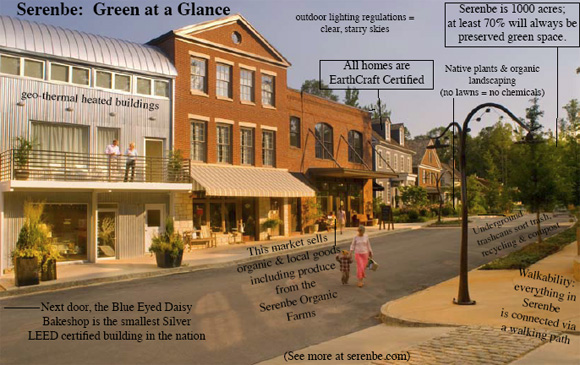There is a beautiful oasis close to Atlanta, GA, but yet far from the hustle and bustle of the city and reminiscent of a simpler time. The place, Serenbe, derived from “Serenity” and “Be,” is not just a place, but a story. It involves the Nygren family, and how the love of a weekend retreat turned into a vision that is a model for planning, acclaimed around the world. Steve Nygren ran a successful restaurant business in eight states. One weekend his wife saw an ad for a farm that was for sale close to the city so they took their girls out to experience the farm and see the animals. While they had no intention of buying the farm that day, they followed their heart. They started going out on weekends and staying in a cabin as they had rented out the main farm house. They soon decided to sell the restaurant business, sell their home in Atlanta and move to the farm. The girls attended local schools and Steve and Marie tended to running a working farm. Nice story, but not usually the type of story I post. Here is what’s most interesting to me.
One day bulldozers arrived to clear trees for a potential housing development. Steve was able to stop the dozers, track down the owner of the land and buy it. And they bought additional land. Their concern was to protect the natural beauty, but then something clicked, that to truly protect this Oasis, Chattahoochee Hill, they would have to get the whole community, including the other neighboring land owners, involved. They hosted community meetings on the potential of a comprehensive development plan. These meetings were contentious to say the least. What kept bringing the neighbors back was Marie’s cobbler. Working with the local governments, getting them to think out of the box, and getting the other property owners to realize that their land would actually be more valuable with this sort of plan, they had a big challenge ahead. Today Serenbe is more than the original farm. There is a hamlet, where people live and go to school. The development is not only a model of environmental sustainability but a deliberate design of including the natural elements into the plan versus blocking them out. It was designed with a true sense of community. A place where neighbors know their neighbors. A place where the community is engaged. Much of the offerings in the market are grown locally. The three restaurants (soon to be four) serve locally grown, and healthy (most of the time) meals. HGTV’s 2012 Green Home is located in Serenbe. www.serenbe.com/greenhome There is interest in this development from urban planners across the country and as far away as China. Steve had to work hard to get these results as the systems set up by various governments work against this type of planning. The plan states that 70% of the land remains undeveloped. But the density in the 30% is much higher than usually allowed. This helps breaking down the “walls’ that separate people and helps build the community feeling. Everything is organic, and so far the residents are healthier than their counterparts in the city. So an area that probably would have turned into mile after mile of housing developments and shopping centers, is a combination of forest, farmland and little communities. This model is proving to be economically sound. Which almost seems too good to be true.
I have had the opportunity to stay at the Inn at Serenbe twice in the last six months and talk with Steve and Marie. As an innovative model of community building through smart development, we held the Points of Light board retreat at the farmhouse this week. As I type this, on my way back to reality. To me, Serenbe demonstrates how much of our existing structure is archaic and to meet the demands of our future economic, environmental and cultural realities, we must not be stuck in our current models and we must be allowed to imagine the possibilities and build a future that is responsible and effective. And the blueberry cobbler really is the best that I have ever had! www.serenbe.com

